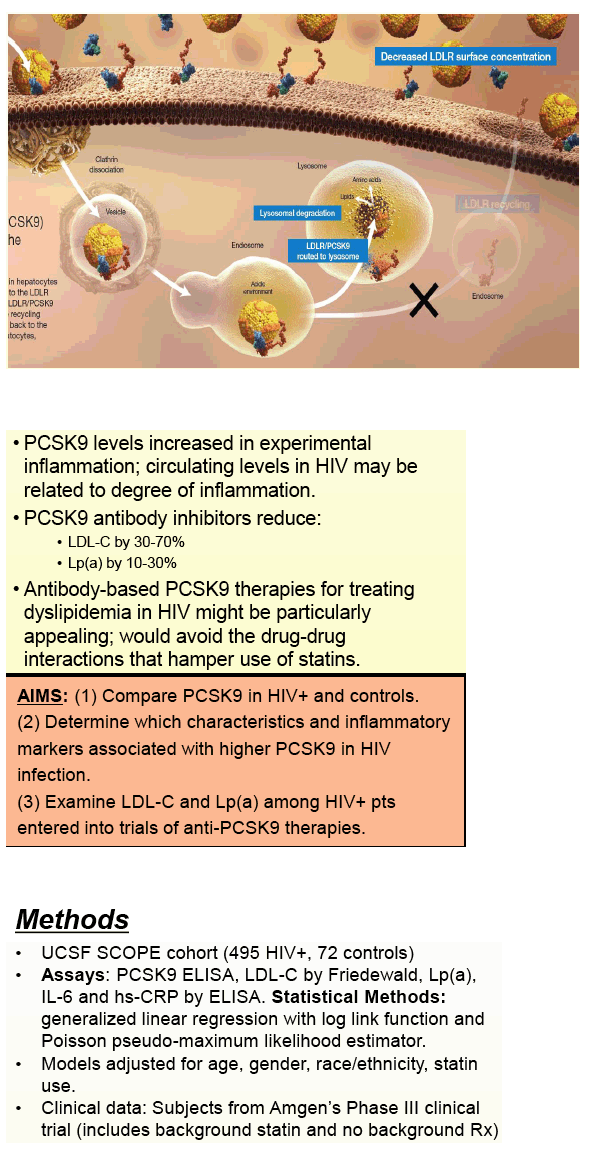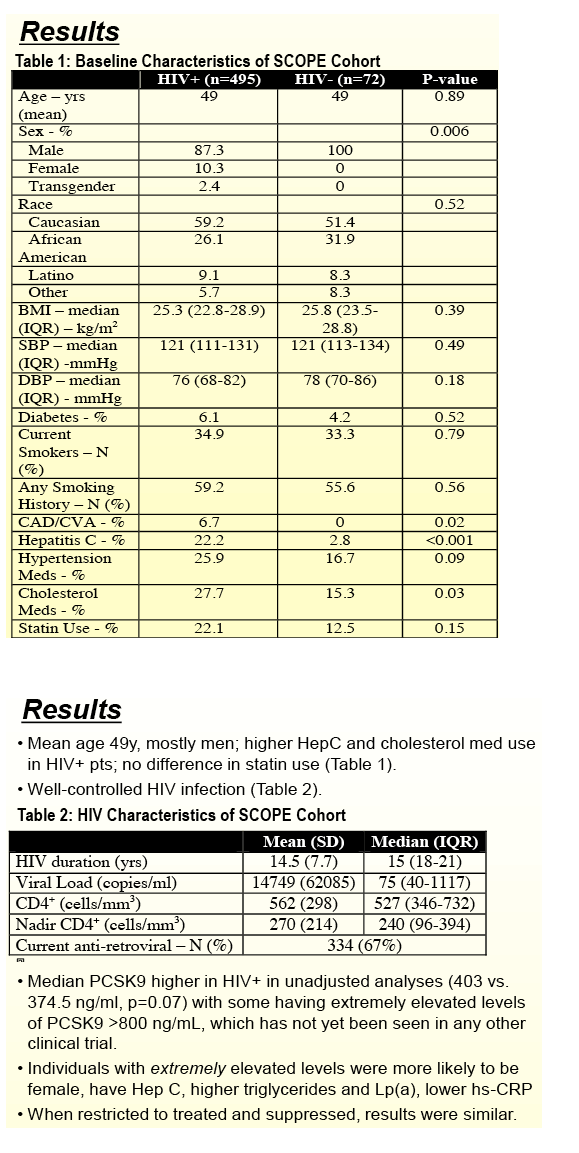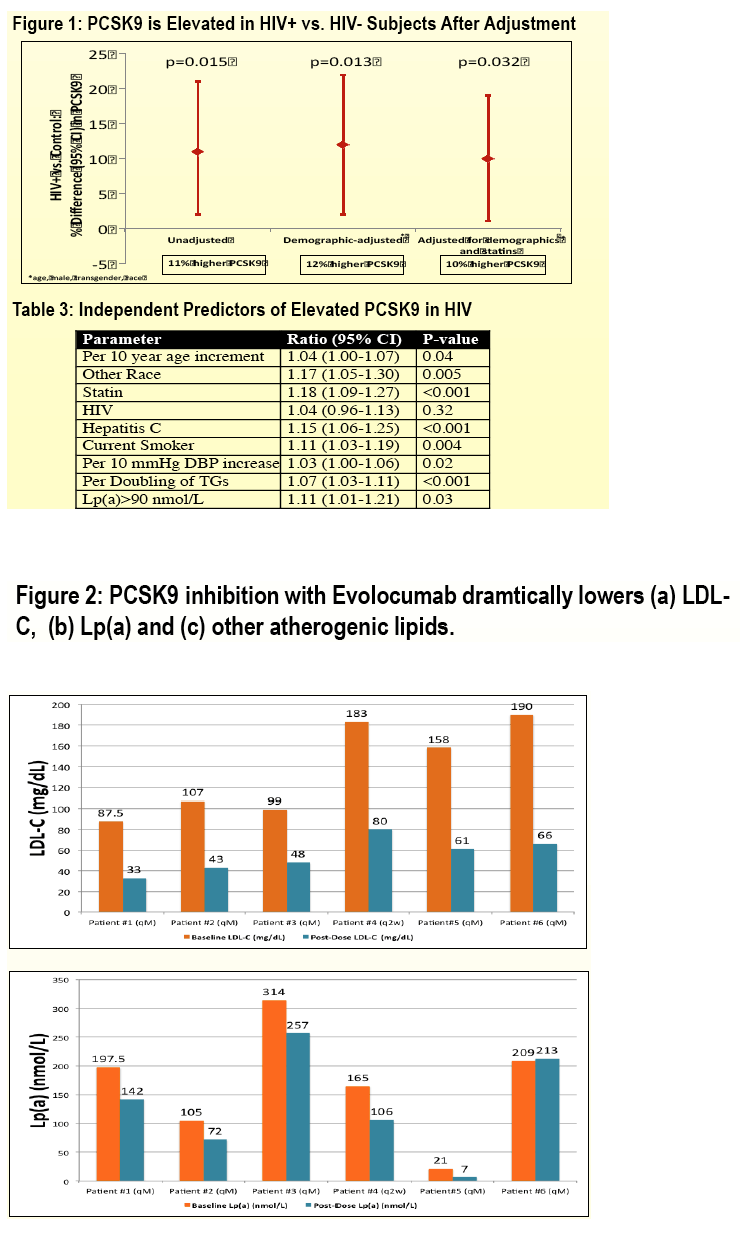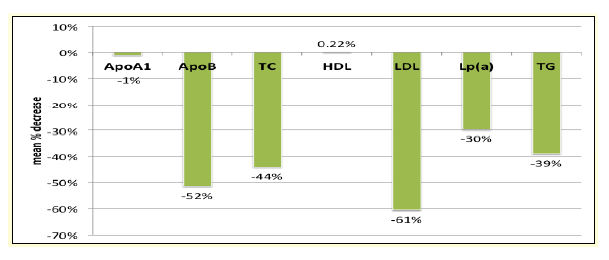 |
 |
 |
| |
PCSK9 is Elevated in HIV+ Patients And May
Mediate HIV-Associated Dyslipidemia
|
| |
| |
CROI 2015, February 23-26, 2015, Seattle, Washington
Payal Kohli MD1, Peter Ganz MD1, Yifei Ma MS2, Rebecca Scherzer PhD3, Steven G. Deeks MD4, Kristinalisa Maka BA1, Scott Wasserman MD5, Rob Scott MD5, Priscilla Hsue MD1 1Division of Cardiology, San Francisco General Hospital, University of California San Francisco, San Francisco, CA 2Division of Medicine, University of California San Francisco, San Francisco, CA, 3San Francisco Veterans Affairs Hospital, San Francisco, CA, 4Positive Health Program, San Francisco General Hospital, San Francisco, CA, 5Amgen Inc, Thousand Oaks, CA
New LDL lowering drug:
The Data as They Look So Far (pdf attached)
Download the PDF here
In DESCARTES, which was led by Dr Dirk Blom (University of Cape Town, South Africa) and published in the New England Journal of Medicine, investigators randomized 901 patients with hypercholesterolemia recently started with lipid-lowering therapy to placebo or evolocumab 420 mg once every four weeks........A 52-Week Placebo-Controlled Trial of Evolocumab in Hyperlipidemia......We found that treatment with 420 mg of evolocumab every 4 weeks for 52 weeks resulted in a relative reduction in LDL cholesterol levels of 57%, taking into account the change in the placebo group. This result was consistent with the effects that were observed with the same evolocumab regimen in the 12-week phase 2 trials.3-6 In addition, we found no decrement in the efficacy of evolocumab from week 12 to week 52. Our findings were also similar to the finding of a relative reduction of 52% in LDL cholesterol levels reported in the first year of the Open-Label Study of Long-Term Evaluation against LDL-C (OSLER) study......http://www.nejm.org/doi/full/10.1056/NEJMoa1316222





What is ApoA1- http://en.wikipedia.org/wiki/Apolipoprotein_A1
Apolipoprotein A-I is a protein that in humans is encoded by the APOA1 gene.[1][2] It has a specific role in lipid metabolism. Recent report suggest that APOA1 mRNA is regulated by endogenously expressed antisense RNA.[3]
Apolipoprotein A-I is the major protein component of high density lipoprotein (HDL) in plasma. Chylomicrons secreted from the intestinal enterocyte also contain apo A-I, but it is quickly transferred to HDL in the bloodstream.[4] The protein promotes fat efflux, including cholesterol, from tissues to the liver for excretion. It is a cofactor for lecithin cholesterolacyltransferase (LCAT) which is responsible for the formation of most plasma cholesteryl esters. Apo A-I was also isolated as a prostacyclin (PGI2) stabilizing factor, and thus may have an anticlotting effect.[5] Defects in the gene encoding it are associated with HDL deficiencies, including Tangier disease, and with systemic non-neuropathic amyloidosis.[6] ApoA1 is often used as a biomarker for prediction of cardiovascular diseases and the ratio apoB- 100/apoA1 has been reported as a stronger predictor for the risk of myocardial infarction than any other lipid measurement.[7] ApoA1 is routinely measured using immunoassays such as ELISA or nephelometry.
WHAT is APOB - http://en.wikipedia.org/wiki/Apolipoprotein_B
Apolipoprotein B is the primary apolipoprotein of chylomicrons, VLDL, IDL, and LDL particles (LDL - known commonly by the misnomer "bad cholesterol" when in reference to both heart disease and vascular disease in general), which is responsible for carrying fat molecules (lipids), including cholesterol, around the body (within the water outside cells) to all cells within all tissues. While all the functional roles of ApoB within the LDL (and all larger) particles remains somewhat unclear, it is the primary organizing protein (of the entire complex shell enclosing/carrying fat molecules within) component of the particles and is absolutely required for the formation of these particles. What is also clear is that the ApoB on the LDL particle acts as a ligand for LDL receptors in various cells throughout the body (i.e., less formally, ApoB indicates fat carrying particles are ready to enter any cells with ApoB receptors and deliver fats carried within into the cells).
Through mechanisms only partially understood, high levels of ApoB, especially associated with the higher LDL particle concentrations, are the primary diver of plaques that cause vascular disease (atherosclerosis), commonly first becoming obviously symptomatic as heart disease, stroke & many other body wide complications after decades of progression. There is considerable evidence that concentrations of ApoB[1][2] and especially the NMR assay[3] (specific for LDL-particle concentrations) are superior indicators of vascular/heart disease driving physiology than either total cholesterol or LDL-cholesterol (as long promoted by the NIH starting in the early 1970s). However, primarily for historic cost/complexity reasons, cholesterol, and estimated LDL-cholesterol by calculation, remains the most commonly promoted lipid test for the risk factor of atherosclerosis. ApoB is routinely measured using immunoassays such as ELISA or nephelometry. Refined and automated NMR methods allow measurement distinctions between the many different ApoB particles.
WHAT is Lp(a) - http://en.wikipedia.org/wiki/Lipoprotein(a)
Lipoprotein(a) (also called Lp(a) or LPA) is a lipoprotein subclass. Genetic studies and numerous epidemiologic studies have identified Lp(a) as a risk factor for atherosclerotic diseases such as coronary heart disease and stroke.[1][2][3][4][5]
|
| |
|
 |
 |
|
|